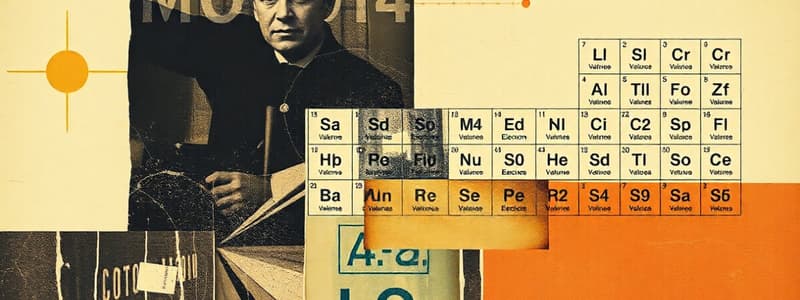Podcast
Questions and Answers
What is the primary reason for metals becoming more reactive as you move down a group in the periodic table?
What is the primary reason for metals becoming more reactive as you move down a group in the periodic table?
Why are noble gases considered non-reactive?
Why are noble gases considered non-reactive?
How does the atomic radius change as you move from right to left across a period in the periodic table?
How does the atomic radius change as you move from right to left across a period in the periodic table?
Which statement best describes the reactivity of non-metals as you move up a group?
Which statement best describes the reactivity of non-metals as you move up a group?
Signup and view all the answers
What determines the size of an atom, often referred to as its atomic radius?
What determines the size of an atom, often referred to as its atomic radius?
Signup and view all the answers
What characteristic trend is observed in the reactivity of elements as you move down a group for metals?
What characteristic trend is observed in the reactivity of elements as you move down a group for metals?
Signup and view all the answers
What role do valence electrons play in chemical reactions?
What role do valence electrons play in chemical reactions?
Signup and view all the answers
Which of the following groups of elements is most likely to be highly reactive?
Which of the following groups of elements is most likely to be highly reactive?
Signup and view all the answers
Study Notes
Reactivity and Valence Electrons
- Elements in the same group have the same number of valence electrons.
- Valence electrons are located in the outermost energy level of an atom.
- Atoms can gain, lose, or share valence electrons during chemical reactions.
- Noble gases are non-reactive because they have a full set of valence electrons, making them chemically stable.
- Elements near noble gases are very reactive because they only need to gain or lose one electron to achieve stability.
Atomic Size and Reactivity
- Atomic radius is the distance from the nucleus to the outermost electrons.
- Atoms get larger as you move down the periodic table.
- As valence electrons are further from the nucleus, the element becomes more reactive.
- Atoms also become larger moving from right to left across a period, increasing their reactivity.
Metal Reactivity
- Metals become more reactive moving down a group.
- Larger atoms have valence electrons further from the nucleus, making them easier to lose.
Non-Metal Reactivity
- Non-metals become more reactive moving up a group.
- Smaller atoms have a stronger nucleus attraction, making it easier to gain electrons.
Studying That Suits You
Use AI to generate personalized quizzes and flashcards to suit your learning preferences.
Related Documents
Description
This quiz covers key concepts related to reactivity and valence electrons in chemistry. Learn about the significance of valence electrons, atomic size, and their relationship with an element's reactivity. Understand how different groups in the periodic table exhibit varying reactivity based on atomic structure.




